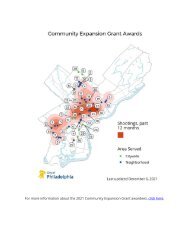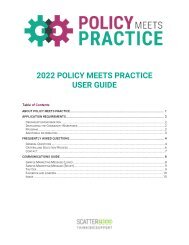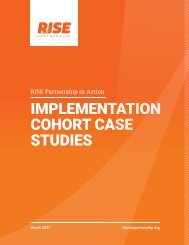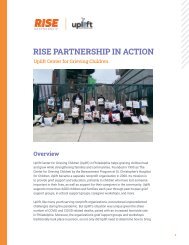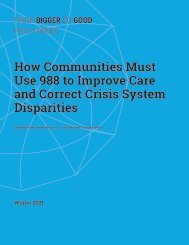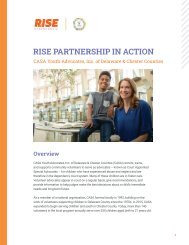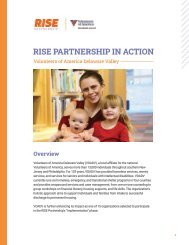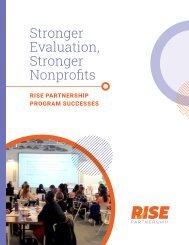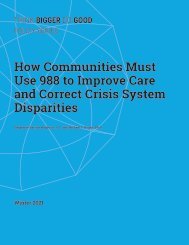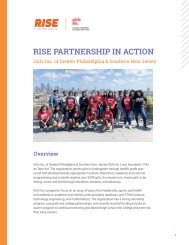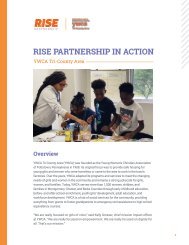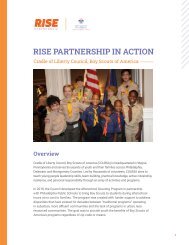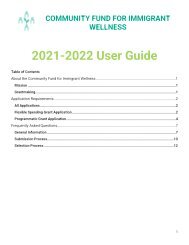Policy Recommendations to Address Housing Shortages for People with Severe Mental Illness
You also want an ePaper? Increase the reach of your titles
YUMPU automatically turns print PDFs into web optimized ePapers that Google loves.
4<br />
The Federal 811<br />
<strong>Housing</strong> Program <strong>for</strong><br />
Persons <strong>with</strong> Disabilities<br />
From 1960 <strong>to</strong> 1990, the federal government invested funds in two legs of the s<strong>to</strong>ol,<br />
capital and operations (as rent subsidies), <strong>for</strong> new housing <strong>for</strong> “handicapped”<br />
people as a subset of an elderly housing program called 202. This was the first<br />
federal attempt at developing housing <strong>for</strong> people <strong>with</strong> disabilities. The need <strong>for</strong><br />
this housing continued <strong>to</strong> be evident, and in 1990, the Crans<strong>to</strong>n-Gonzalez National<br />
Af<strong>for</strong>dable <strong>Housing</strong> Act provided <strong>for</strong> a special program, Supportive <strong>Housing</strong> <strong>for</strong><br />
Persons <strong>with</strong> Disabilities, referred <strong>to</strong> as 811 (“eight-eleven”) (14).<br />
Through 811, nonprofit organizations applied directly <strong>to</strong> HUD <strong>for</strong> capital grants,<br />
accompanied by 5-year commitments <strong>for</strong> rental subsidies as PBRA. <strong>Housing</strong><br />
types <strong>for</strong> development could include group homes, independent living facilities,<br />
multifamily rental units, condominium units, and cooperative housing <strong>with</strong><br />
limitations on size—not more than eight or 16 units depending on the type. The<br />
nonprofit receiving the 811 funds committed <strong>to</strong> providing the third leg of the<br />
s<strong>to</strong>ol—services. The 811 program also awarded stand-alone TBRA subsidies but at<br />
a smaller amount.<br />
This model provided nonprofit groups, many of which were small organizations,<br />
a single source application <strong>for</strong> two of the funds hardest <strong>to</strong> come by <strong>for</strong> af<strong>for</strong>dable<br />
housing. This was a boon <strong>to</strong> local providers wanting <strong>to</strong> house their own clients<br />
and <strong>for</strong> those in areas <strong>with</strong> little or no capital. The commitment <strong>for</strong> 5 years of<br />
rental subsidy <strong>with</strong> the capital allowed clients <strong>to</strong> skip the long waiting lists <strong>for</strong><br />
other rent subsidies.<br />
What did 811 produce? Actual numbers of units created <strong>for</strong> persons <strong>with</strong><br />
disabilities since 1960 are unknown, but HUD estimates that 30,000 units were<br />
created from 1990 through 2010—or 1,500 new units a year (15). That is a paltry and<br />
low national production pipeline. The units had <strong>to</strong> be available <strong>to</strong> any disability<br />
class as long as the person was age 18 <strong>to</strong> 61. As a result, many units did not house<br />
people <strong>with</strong> mental illness, further diluting the impact <strong>for</strong> this population.<br />
<strong>Policy</strong> <strong>Recommendations</strong> <strong>to</strong> <strong>Address</strong> <strong>Housing</strong> <strong>Shortages</strong> <strong>for</strong> <strong>People</strong> <strong>with</strong> <strong>Severe</strong> <strong>Mental</strong> <strong>Illness</strong> 17




